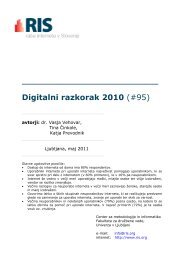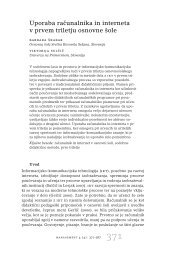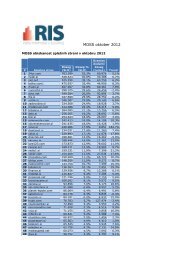the Labour Market Survey Report - Council of European ...
the Labour Market Survey Report - Council of European ...
the Labour Market Survey Report - Council of European ...
You also want an ePaper? Increase the reach of your titles
YUMPU automatically turns print PDFs into web optimized ePapers that Google loves.
Probably <strong>the</strong> greatest challenge in this area arises from <strong>the</strong> widely-observed, growing, perceived<br />
unattractiveness to young people <strong>of</strong> both genders <strong>of</strong> work as an IT Practitioner, as evidenced in<br />
particular by <strong>the</strong> significant fall in applications from <strong>the</strong> most academically-able young people to<br />
study engineering and IT courses in higher education. A recent study by Bruniaux, Hansen, Steedman,<br />
Vignoles and Wagner (2000) reviews this situation in a number <strong>of</strong> countries, and confirms <strong>the</strong> problems<br />
with student applicants in terms <strong>of</strong> quantity and/or “quality”.<br />
Debate continues as to whe<strong>the</strong>r <strong>the</strong> technical aspects <strong>of</strong> IT Practitioner work require formal learning<br />
through public education channels (in particular in tertiary education in Information Technology related<br />
courses), or whe<strong>the</strong>r employers prefer (not least in <strong>the</strong> light <strong>of</strong> <strong>the</strong>ir higher average prior academic<br />
achievement!) to recruit “good” graduates from non-technical degree subjects, who are subsequently<br />
trained in some depth on <strong>the</strong> technical aspects <strong>of</strong> <strong>the</strong> work over <strong>the</strong>ir early months <strong>of</strong> employment.<br />
However, whe<strong>the</strong>r <strong>the</strong> supply <strong>of</strong> new IT Practitioners is to come from university IT courses or from<br />
any o<strong>the</strong>r education source, where <strong>the</strong> supply <strong>of</strong> young people is considered, certain realities <strong>of</strong><br />
<strong>the</strong> education -> working life transition need to be understood, and this transition has different<br />
characteristics in different Member States. The <strong>European</strong> Centre for <strong>the</strong> Development <strong>of</strong> Vocational<br />
Learning (CEDEFOP) has recently published <strong>the</strong> results <strong>of</strong> an extended study on this matter (CEDEFOP<br />
2001), which, drawing on a common conceptual framework, covers <strong>the</strong> institutional characteristics <strong>of</strong><br />
national education systems, <strong>the</strong> beginning <strong>of</strong> <strong>the</strong> transition process, labour market entrants, and <strong>the</strong><br />
integration <strong>of</strong> young people into working life & community policies.<br />
3.4 Experience with Relevant Initiatives<br />
As will be seen, many national governments have introduced initiatives over recent years in response to<br />
perceived shortages <strong>of</strong> ICT skills. A preliminary “inventory” <strong>of</strong> <strong>the</strong>se is provided in an interim review by<br />
<strong>the</strong> World Information Technology and Services Alliance (WITSA), based on returns from its members in<br />
16 countries (+EU as a whole), which is available on <strong>the</strong>ir website (www.witsa.org). These public policy<br />
interventions have undoubtedly had an impact, but this has <strong>of</strong>ten turned out relatively small in relation<br />
to <strong>the</strong> effects <strong>of</strong> market behaviour. Two ra<strong>the</strong>r significant national programmes have been <strong>the</strong> “SwIT”<br />
initiative in Sweden and <strong>the</strong> “Bug-buster” training project within <strong>the</strong> UK, both <strong>of</strong> which have achieved a<br />
level <strong>of</strong> useful IT training for tens <strong>of</strong> thousands <strong>of</strong> people within relatively short timeframes (see Annex F).<br />
3.5 Roles <strong>of</strong> National and <strong>European</strong> Policy-Makers<br />
The <strong>European</strong> Commission reviews Europe’s strategic position in relation to <strong>the</strong> rest <strong>of</strong> <strong>the</strong> world, and<br />
initiates programmes to support <strong>the</strong> development <strong>of</strong> world class capabilities in <strong>the</strong> economic and o<strong>the</strong>r<br />
domains, in particular to streng<strong>the</strong>n Europe’s competitiveness in relation to growing globalisation. The<br />
budget for this is relatively modest, and thus it is important for <strong>the</strong> Commission to identify, with Member<br />
States’ help, areas where national development work can contribute to achieving <strong>the</strong>se world-class<br />
standards, through upgrading <strong>the</strong> national supply <strong>of</strong> skills.<br />
30<br />
| C E P I S I.T. PRACTITIONER SKILLS IN EUROPE | Section 3

















